Search Result
Results for "
sustained
" in MedChemExpress (MCE) Product Catalog:
1
Biochemical Assay Reagents
5
Isotope-Labeled Compounds
| Cat. No. |
Product Name |
Target |
Research Areas |
Chemical Structure |
-
- HY-12839
-
p38 MAPK-IN-1
Maximum Cited Publications
8 Publications Verification
|
p38 MAPK
Autophagy
|
Inflammation/Immunology
|
|
p38 MAPK-IN-1 (Compound 4) is a novel potent and selective inhibitor of p38 MAPK with IC50 of 68 nM. p38 MAPK-IN-1 shows sustained levels, low clearance and good bioavailability.
|
-

-
- HY-100744
-
-
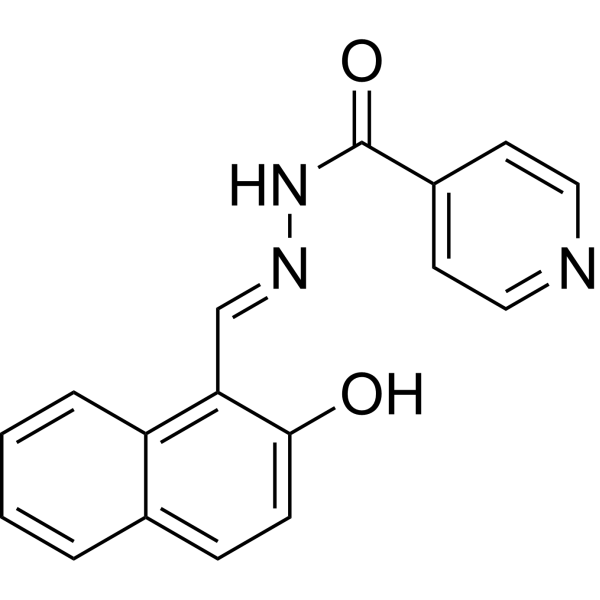
-
- HY-P5819A
-
|
|
PROTACs
β-catenin
|
Cancer
|
|
xStAx-VHLL TFA, a PROTAC, sustains β-catenin degradation and manifested strong inhibition of Wnt signaling. xStAx-VHLL TFA promotes β-catenin ubiquitination .
|
-

-
- HY-P99022
-
|
|
Amyloid-β
|
Neurological Disease
|
|
Gantenerumab is a fully human anti-amyloid-β (Aβ) IgG1 monoclonal antibody demonstrates sustained cerebral amyloid-β binding. Gantenerumab can be used for Alzheimer's disease research .
|
-

-
- HY-27979
-
|
|
Biochemical Assay Reagents
|
Others
|
|
Ethyl acrylate-methyl methacrylate copolymer can be used as an excipient, such as sustained-release coating materials, matrix sustained-release tablet binders and retarders. Pharmaceutical excipients, or pharmaceutical auxiliaries, refer to other chemical substances used in the pharmaceutical process other than pharmaceutical ingredients. Pharmaceutical excipients generally refer to inactive ingredients in pharmaceutical preparations, which can improve the stability, solubility and processability of pharmaceutical preparations. Pharmaceutical excipients also affect the absorption, distribution, metabolism, and elimination (ADME) processes of co-administered drugs .
|
-

-
- HY-P1817
-
|
|
PACAP Receptor
|
Neurological Disease
|
|
PACAP-38 (16-38), human, mouse, rat demonstrates potent, efficacious, and sustained stimulatory effects on sympathetic neuronal NPY and catecholamine production . PACAP is a potent activator of cAMP formation .
|
-

-
- HY-148281
-
|
|
Bcl-2 Family
|
Cancer
|
|
TMX-2164 is a potent, irreversible B-cell lymphoma 6 (BCL6) inhibitor with an IC50 value of 152 nM. TMX-2164 displays sustained target engagement and antiproliferative activity in cells .
|
-
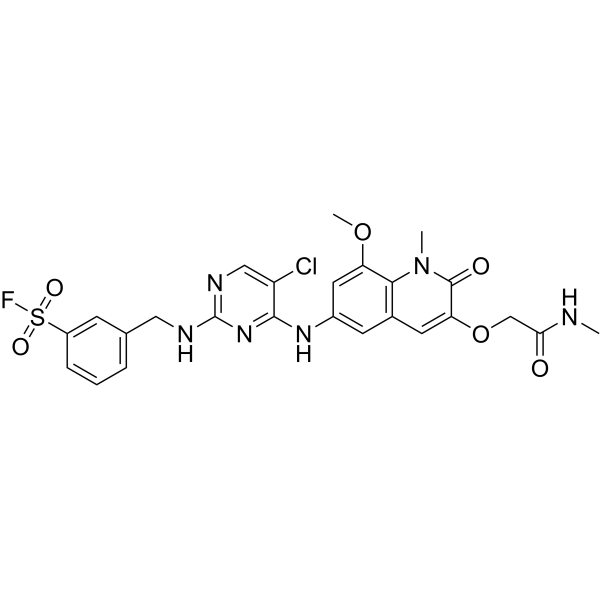
-
- HY-132247
-
|
|
Others
|
Cancer
|
|
ErSO is a selective anticipatory unfolded protein response (a-UPR) activator. ErSO acts through ERα to elicit strong and sustained cytotoxic activation of the a-UPR. ErSO can be used for the research of cancer .
|
-
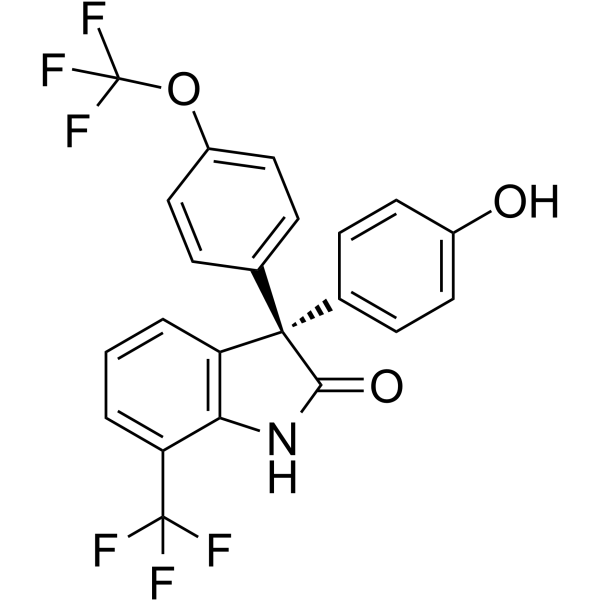
-
- HY-108502
-
|
|
Sodium Channel
|
Cardiovascular Disease
|
|
KC 12291 hydrochloride is an orally active blocker of voltage-gated sodium channel (VGSC). KC 12291 hydrochloride reduces the amplitude of sustained Na + current to exert antiischemic activity. KC 12291 hydrochloride has significant cardioprotective effect in vitro and in vivo .
|
-

-
- HY-135195
-
|
|
GLP Receptor
|
Metabolic Disease
|
|
Boc5 is a non-peptidic glucagon-like peptide-1 receptor agonist. Boc5 causes sustained glycemic control and weight loss in diabetic mice. Boc5 can be used in research of diabetic .
|
-

-
- HY-106828
-
|
Estradiol 17-Dihydrotrigonelline
|
Others
|
Metabolic Disease
|
|
E2-CDS (Estradiol 17-Dihydrotrigonelline) is a redox-based chemical delivery system for estradiol (E2). E2-CDS is capable of sustained and brain-selective delivery of estradiol .
|
-
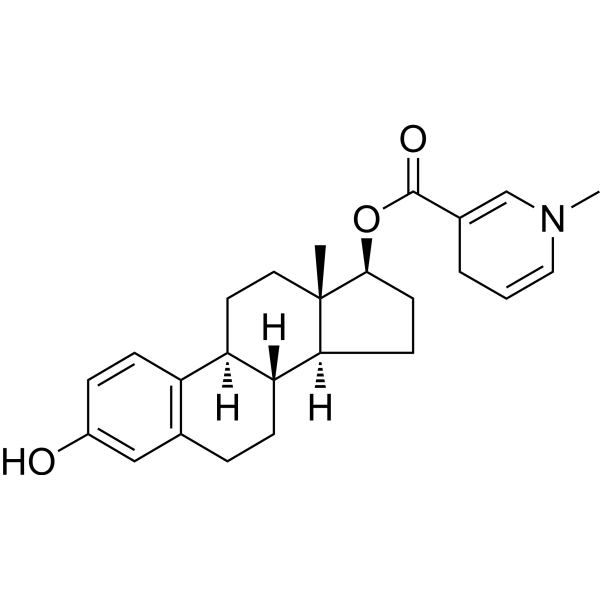
-
- HY-12825
-
|
|
Estrogen Receptor/ERR
|
Cancer
|
|
BHPI is a potent inhibitor of nuclear estrogen–ERα-regulated gene expression; elicits sustained ERα-dependent activation of the endoplasmic reticulum (EnR) stress sensor, the unfolded protein response (UPR), and persistent inhibition of protein synthesis.
|
-

-
- HY-P4678
-
|
|
Vasopressin Receptor
|
Neurological Disease
|
|
(Phe2,Orn8)-Oxytocin is a selective V1 vasopressin agonist. (Phe2,Orn8)-Oxytocin induces a sustained contractility of rabbit epididymis with EC50 value of 280 nM .
|
-
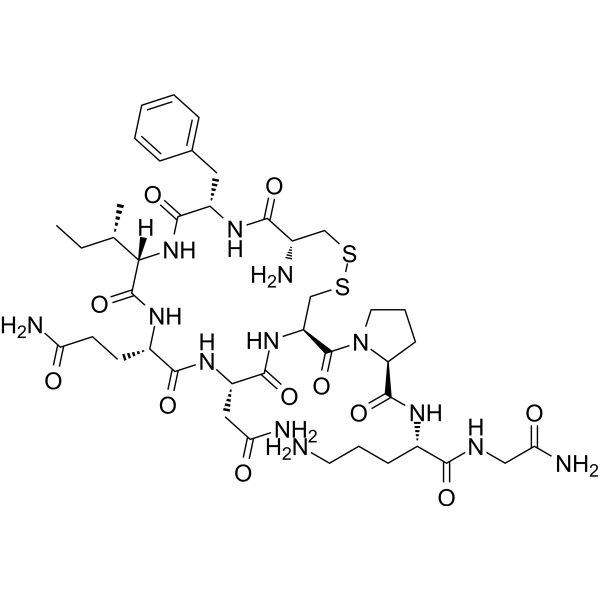
-
- HY-P4678A
-
|
|
Vasopressin Receptor
|
Neurological Disease
|
|
(Phe2,Orn8)-Oxytocin acetate is a selective V1 vasopressin agonist. (Phe2,Orn8)-Oxytocin acetate induces a sustained contractility of rabbit epididymis with EC50 value of 280 nM .
|
-
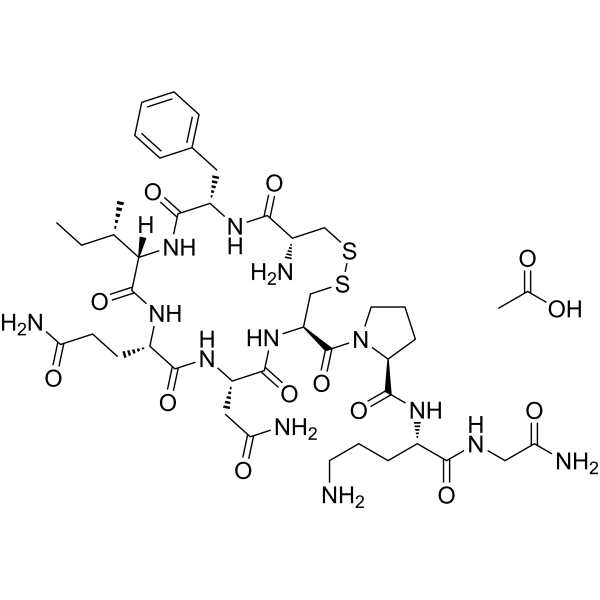
-
- HY-P1249
-
|
|
Neuropeptide Y Receptor
|
Neurological Disease
|
|
Neuropeptide SF (mouse,rat) is a potent neuropeptide FF receptor agonist with Ki values are 48.4 nM and 12.1 nM for NPFF1 and NPFF2, respectively. Neuropeptide SF increases the amplitude of the sustained current of heterologously expressed acid sensing ion channel 3 (ASIC3) .
|
-

-
- HY-119691
-
|
LY582563; MCC-478
|
HBV
|
Infection
|
|
Alamifovir (LY582563; MCC-478), a purine nucleotide analogue proagent, shows potent activity against wild type and lamivudine resistant hepatitis B virus (HBV). Alamifovir has high activity against HBV replication and sustained antiviral effect .
|
-
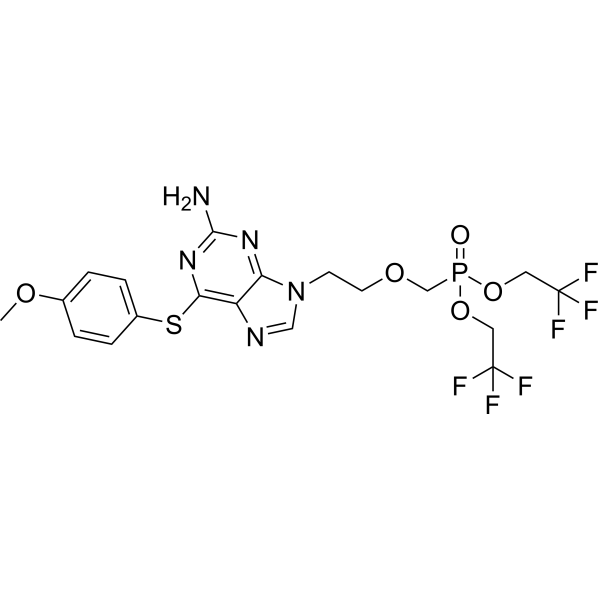
-
- HY-P99846
-
|
QAX576
|
Interleukin Related
|
Inflammation/Immunology
|
|
Dectrekumab (QAX576) is a human monoclonal antibody that targets IL-13. Dectrekumab significantly improves intraepithelial esophageal eosinophil counts and dysregulated esophageal disease-related transcripts with Eosinophilic esophagitis (EoE) in a sustained manner and can be used for inflammation and immunology related research .
|
-

-
- HY-15344A
-
|
(S,S)-Ketone Ester
|
Others
|
Neurological Disease
|
|
(S,S)-BD-AcAc 2 ((S,S)-Ketone Ester) is a (S,S)-enantiomer of BD-AcAc 2. BD-AcAc 2 elevates the AcAc and acetone levels, thereby produces sustained ketosis and significantly delays central nervous system oxygen toxicity (CNS-OT) seizures .
|
-
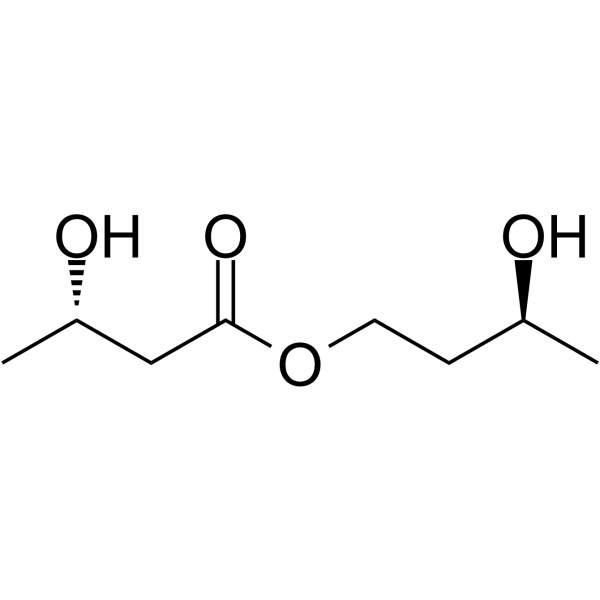
-
- HY-P5819
-
|
|
Wnt
APC
PROTACs
β-catenin
|
Cancer
|
|
xStAx-VHLL is a PROTAC β-catenin degrader that manifests strong inhibition of Wnt signaling and sustains degradation of β-catenin in cancer cells and the intestinal organoids derived from wild-type and APC –/– mice. xStAx-VHLL can be used as a promising anticancer agent .
|
-

-
- HY-15838
-
ID-8
4 Publications Verification
|
DYRK
|
Cancer
|
|
ID-8 is an inhibitor of dual-specificity tyrosine phosphorylation-regulated kinase (DYRK). ID-8 sustains embryonic stem cell (ESC) self-renewal and pluripotency. ID-8 enhances Wnt-mediated hESC survival and proliferation via inhibition of DYRKs .
|
-
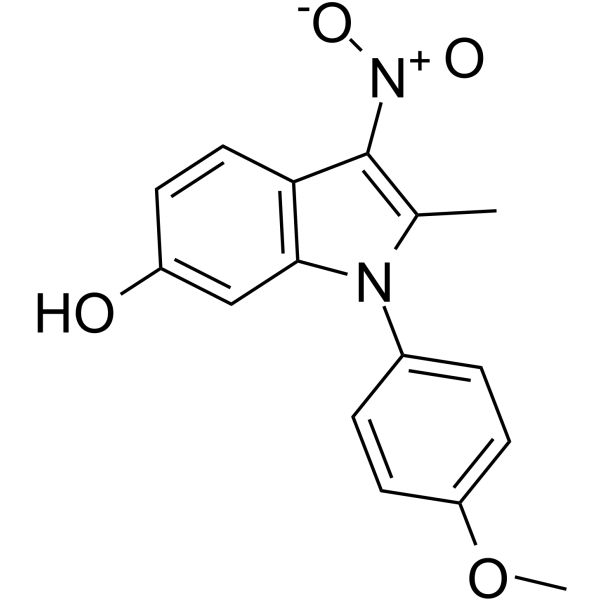
-
- HY-P1249A
-
|
|
Neuropeptide Y Receptor
|
Neurological Disease
|
|
Neuropeptide SF (mouse,rat) TFA is a potent neuropeptide FF receptor agonist with Ki values are 48.4 nM and 12.1 nM for NPFF1 and NPFF2, respectively. Neuropeptide SF TFA increases the amplitude of the sustained current of heterologously expressed acid sensing ion channel 3 (ASIC3) .
|
-
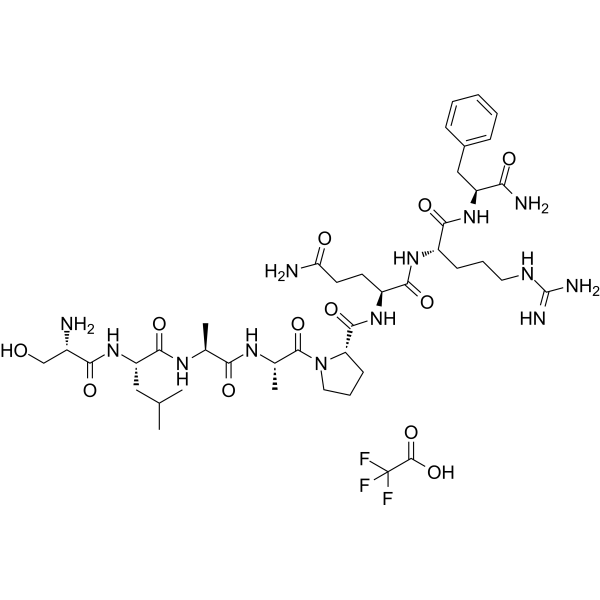
-
- HY-141438
-
SIM1
1 Publications Verification
|
PROTACs
Epigenetic Reader Domain
|
Cancer
|
|
SIM1 is a potent von Hippel-Lindau (VHL)-based trivalent PROTAC capable of degradation for all BET family members, with preference for BRD2 degradation (IC50=1.1 nM; Kd=186 nM). SIM1 shows sustained anti-cancer activity .
|
-
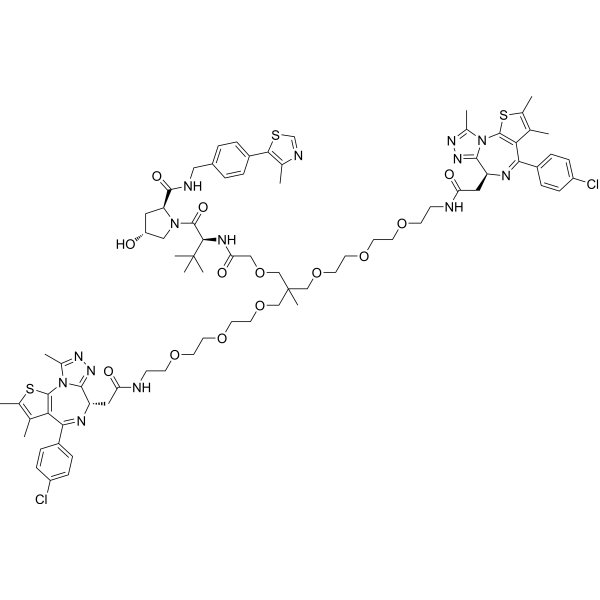
-
- HY-125232
-
|
|
Epigenetic Reader Domain
|
Cancer
|
|
MS645 is a bivalent BET bromodomains (BrD) inhibitor with a Ki of 18.4 nM for BRD4-BD1/BD2. MS645 spatially constrains bivalent inhibition of BRD4 BrDs resulting in a sustained repression of BRD4 transcriptional activity in solid-tumor cells .
|
-
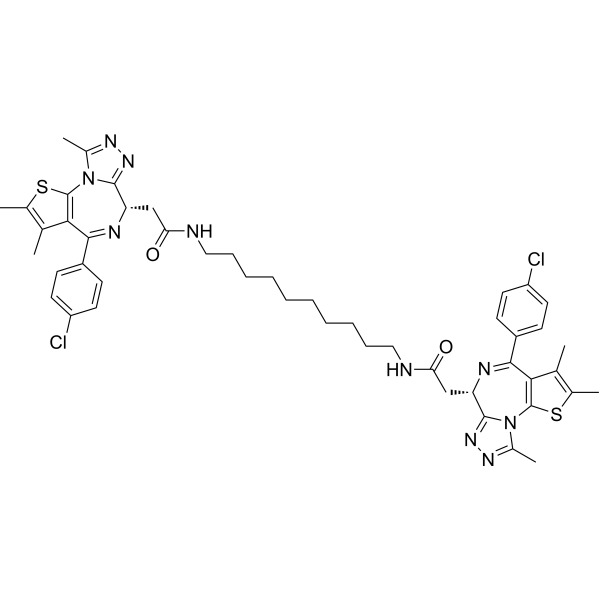
-
- HY-135785
-
|
|
Acyltransferase
|
Metabolic Disease
|
|
OSMI-3 (Compound 2b) is a potent, long-lasting, and cell-permeable O-linked N-acetylglucosamine transferase (OGT) inhibitor. Cells contain a large nuclear pool of partially spliced OGT transcript, and OSMI-3 increases detained intron splicing in cells .
|
-
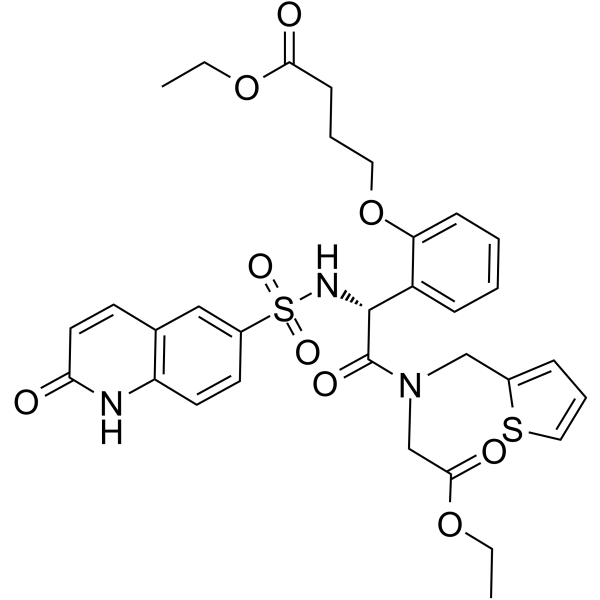
-
- HY-117059
-
|
|
Dopamine Receptor
|
Neurological Disease
|
|
SK609 hydrochloride is a dopamine D3 receptor (D3R) selective agonist with an EC50 of 1109 nM. SK609 hydrochloride has the potential for parkinson research .
|
-

-
- HY-145572
-
|
LY-3484356
|
Estrogen Receptor/ERR
|
Cancer
|
|
Imlunestrant (LY-3484356) is an orally active, potent and selective estrogen receptor degrader (SERD) with pure antagonistic properties. Imlunestrant results in sustained inhibition of ER-dependent gene transcription and cell growth. Imlunestrant can be used for the research of ER-positive (ER+) advanced breast cancer (aBC) and endometrial endometrioid cancer (EEC) .
|
-
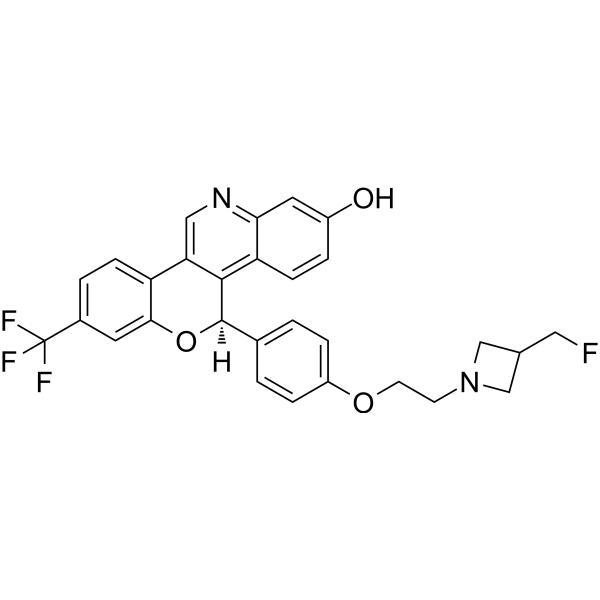
-
- HY-117985
-
|
DA-1229
|
Dipeptidyl Peptidase
Autophagy
|
Metabolic Disease
Inflammation/Immunology
|
|
Evogliptin (DA-1229) is an orally active DPP4 inhibitor with significant and sustained hypoglycaemic effects in mouse models. Evogliptin also inhibits the production of inflammatory and fibrotic signals in hepatocytes by inducing autophagy. Evogliptin can be used in studies of type 2 diabetes, osteoporosis, renal impairment and chronic liver inflammation .
|
-
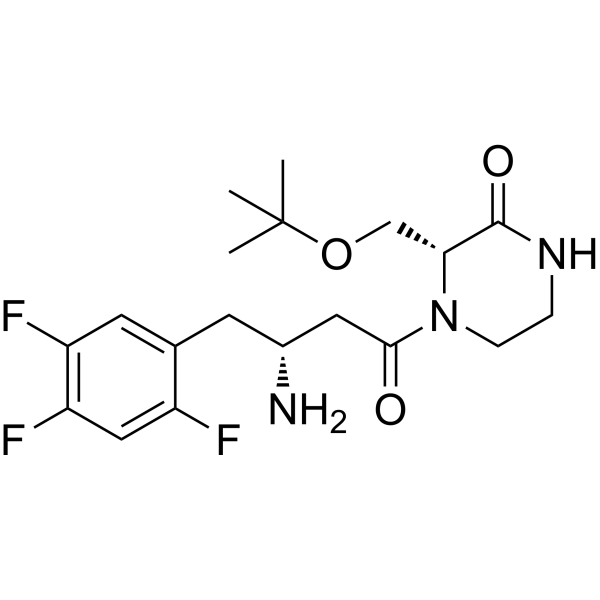
-
- HY-145572A
-
|
LY-3484356 tosylate
|
Estrogen Receptor/ERR
|
Cancer
|
|
Imlunestrant (LY-3484356) tosylate is an orally active, potent and selective estrogen receptor degrader (SERD) with pure antagonistic properties. Imlunestrant tosylate results in sustained inhibition of ER-dependent gene transcription and cell growth. Imlunestrant tosylate can be used for the research of ER-positive (ER+) advanced breast cancer (aBC) and endometrial endometrioid cancer (EEC) .
|
-
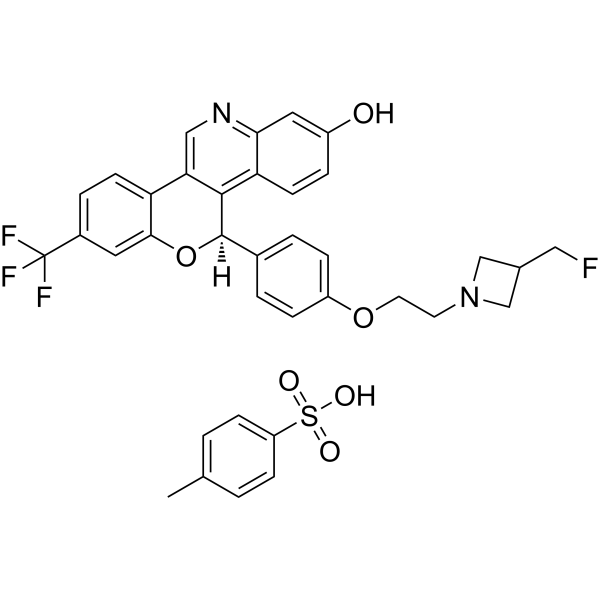
-
- HY-117985B
-
|
DA-1229 tartrate
|
Dipeptidyl Peptidase
Autophagy
|
Metabolic Disease
Inflammation/Immunology
|
|
Evogliptin (DA-1229) tartrate is an orally active DPP4 inhibitor with significant and sustained hypoglycaemic effects in mouse models. Evogliptin tartrate also inhibits the production of inflammatory and fibrotic signals in hepatocytes by inducing autophagy. Evogliptin tartrate can be used in studies of type 2 diabetes, osteoporosis, renal impairment and chronic liver inflammation .
|
-
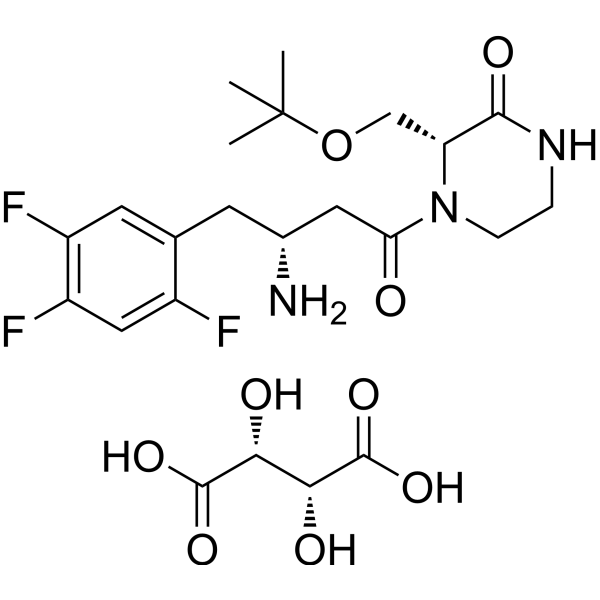
-
- HY-109052
-
|
JNJ-54861911
|
Beta-secretase
|
Neurological Disease
|
|
Atabecestat (JNJ-54861911) is a potent brain-penetrant and orally active β-site amyloid precursor protein cleaving enzyme 1 (BACE1) inhibitor, achieves robust and high CSF Aβ reduction. Atabecestat s tolerated and displays a sustained pharmacokinetic (PK) and pharmacodynamic (PD) characteristics. Atabecestat has the potential for Alzheimer's Disease treatment .
|
-
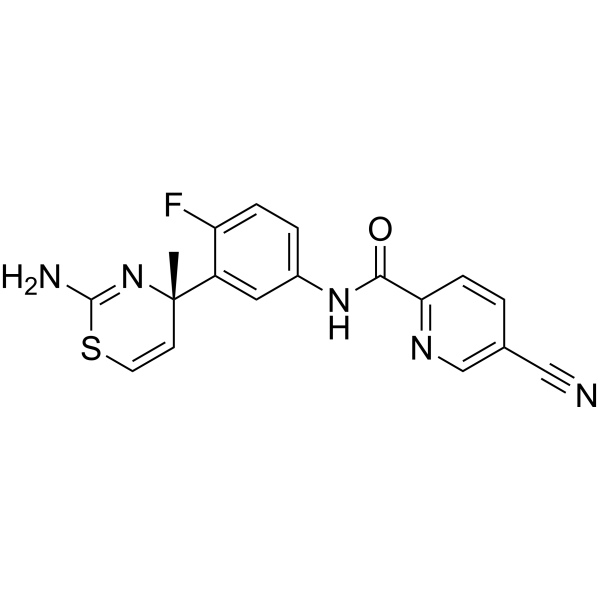
-
- HY-B2221
-
|
Pectin glycosidase
|
Endogenous Metabolite
|
Others
|
|
Cellulose (Pectin glycosidase) is a natural high molecular weight polysaccharide found in many plants and organisms. It is widely used in manufacturing industries, such as in paper making, textiles, food and medicine, etc. As a renewable resource, Cellulose is biodegradable and sustainable, and can also be used to manufacture chemicals such as Cellulose Esters, Cellulose Acetate and Cellulose Nitrate. In addition, Cellulose is often used as a food additive to increase the stability and quality of food.
|
-

-
- HY-157792
-
|
|
mAChR
|
Neurological Disease
|
Antidepressant agent 6 (S-3a) is a lead compound with potent and sustained antidepressant effects. Antidepressant agent 6 (S-3a) displays high cognitive safety margin.Antidepressant agent 6 (S-3a) antagonizes M1 receptors and elevates BDNF levels, suggesting its potential as an antidepressant for further exploration .
|
-
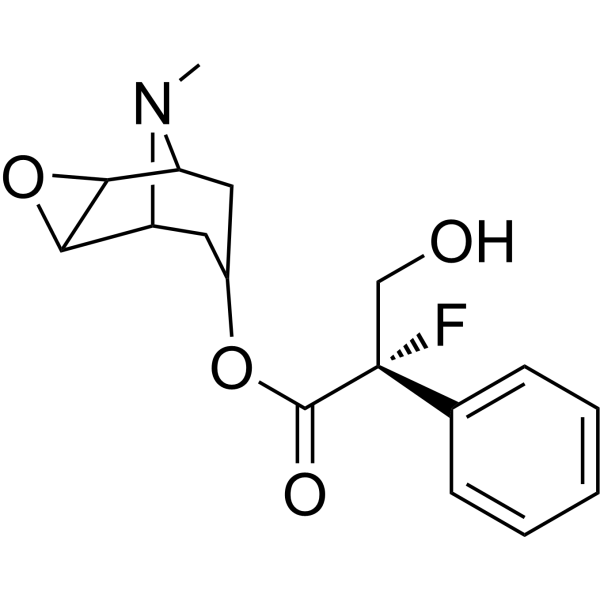
-
- HY-124796
-
|
|
Bacterial
|
Infection
|
|
QStatin is a potent and selective inhibitor of SmcR (V. harveyi LuxR homologue) with an EC50 of 208.9 nM, binding tightly to SmcR and changes the flexibility of the protein, thereby altering its transcription regulatory activity. QStatin shows pan-QS (Vibrio quorum sensing) inhibitor activity in diverse Vibrio species and attenuates their virulence in an aquatic host. QStatin may be a sustainable antivibriosis agent useful in aquacultures .
|
-

-
- HY-153255
-
|
|
Beta-secretase
|
Neurological Disease
|
|
BACE1-IN-13 (Compound 36) is an orally active BACE1 inhibitor with an IC50 value of 2.9 nM. BACE1-IN-13 is highly potent in hAβ42 cell (IC50 = 1.3 nM). BACE1-IN-13 has cardiovascularly safty and elicits sustained Aβ42 reduction in mouse and dog animal models .
|
-
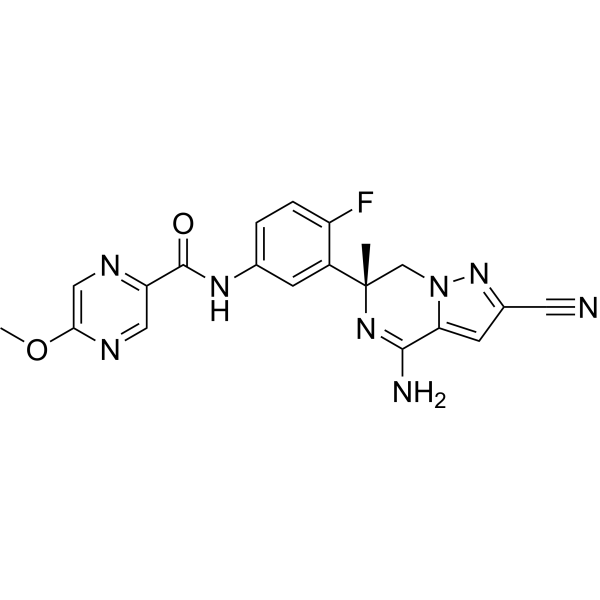
-
- HY-156829
-
|
|
Others
|
Cancer
|
|
PLGA-PEG-PLGA (1500-1500-1500) (LA/GA 1:1) is a matrix materia, with lactic acid (LA):glycolic acid (GA) = 1:1, that acts as anti-cancer drug delivery. PLGA-PEG-PLGA (1500-1500-1500) (LA/GA 1:1) can improve a drug's bioavailability, efficacy, water solubility, drug encapsulation efficiency, sustained drug release, and to minimize undesirable toxicity .
|
-

-
- HY-156829A
-
|
|
Others
|
Cancer
|
|
PLGA-PEG-PLGA (1500-1500-1500) (LA/GA 15:1) is a matrix materia, with lactic acid (LA):glycolic acid (GA) = 15:1, that acts as anti-cancer drug delivery. PLGA-PEG-PLGA (1500-1500-1500) (LA/GA 15:1) can improve a drug's bioavailability, efficacy, water solubility, drug encapsulation efficiency, sustained drug release, and to minimize undesirable toxicity .
|
-
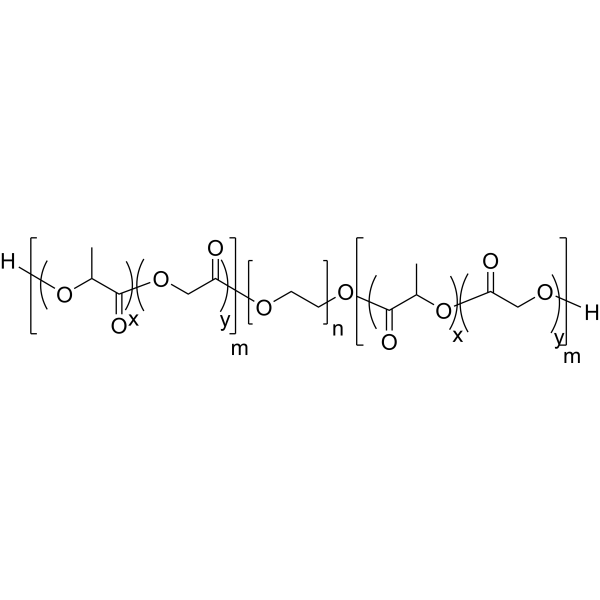
-
- HY-130609
-
|
|
γ-secretase
|
Neurological Disease
|
|
Aβ42-IN-1, compound 1v, is a novel, potent and orally active γ-secretase modulator (GSM). Aβ42-IN-1 potently reduced Aβ42 levels with an IC50 value of 0.091 µM without CYP3A4 inhibition. Aβ42-IN-1 shows a sustained pharmacokinetic profile.
|
-
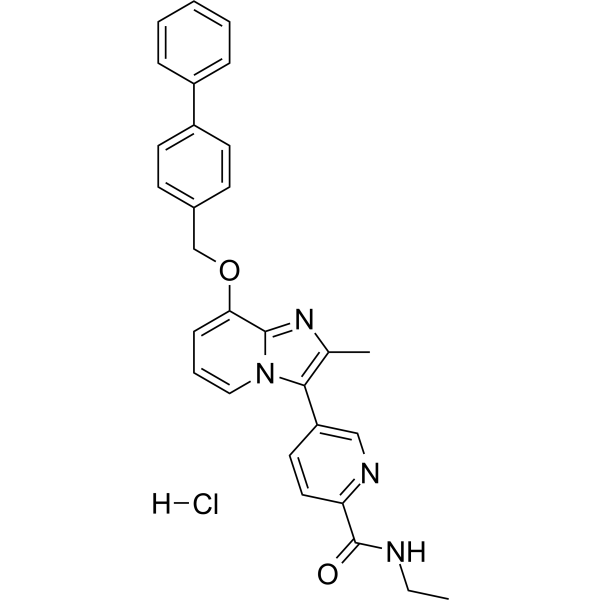
-
- HY-B0432
-
|
SA-79
|
Sodium Channel
Adrenergic Receptor
Potassium Channel
|
Cardiovascular Disease
Cancer
|
|
Propafenone (SA-79), a sodium-channel blocker, acts an antiarrhythmic agent. Propafenone also has high affinity for the β receptor (IC50=32 nM) . Propafenone blocks the transient outward current (Ito) and the sustained delayed rectifier K current (Isus) with IC50 values of 4.9 μm and 8.6 μm, respectively . Propafenone suppresses esophageal cancer proliferation through inducing mitochondrial dysfunction and induce apoptosis .
|
-

-
- HY-P3444
-
|
PECAM-1
|
SHP2
Bacterial
|
Metabolic Disease
Inflammation/Immunology
|
|
CD31 (PECAM-1) is platelet endothelial cell adhesion molecule-1, serves as the endothelial cell-specific receptor of clostridium perfringens b-Toxin (CPB). CD31 is also an ER-MP12 antigen, acts as a linker between mechanical stress, metabolism and inflammation. CD31 peptide is able to sustain phosphorylation of the CD31 ITIM686 and of SHP2 and to inhibit TCR-induced T-cell activation - .
|
-

-
- HY-111553
-
|
|
EGFR
|
Cancer
|
|
TAS0728 is a potent, selective, orally active, irreversible and covalent-binding HER2 inhibitor, with an IC50 of 13 nM. TAS0728 also shows IC50s of 4.9, 8.5, 31, 65, 33, 25 and 86 nM for BMX、HER4、BLK、EGFR、JAK3、SLK and LOK respectively. Furthermore, TAS0728 exhibits robust and sustained inhibition of the phosphorylation of HER2HER3, and downstream effectors .
|
-
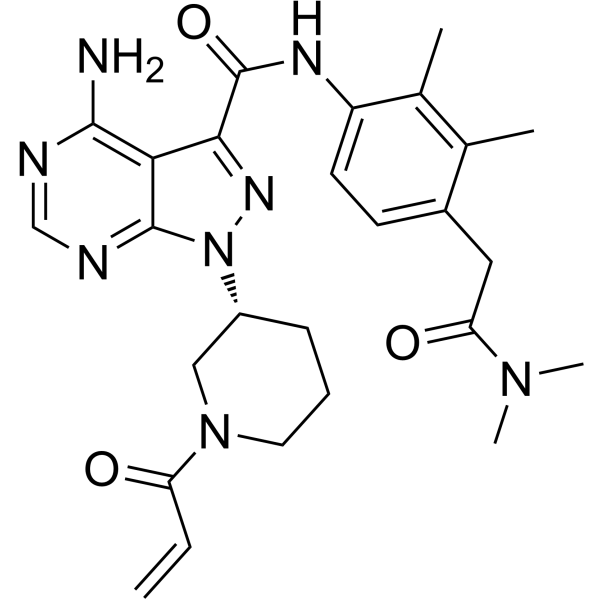
-
- HY-P3444A
-
|
PECAM-1 TFA
|
SHP2
Bacterial
|
Metabolic Disease
Inflammation/Immunology
|
|
CD31 (PECAM-1) TFA is platelet endothelial cell adhesion molecule-1, serves as the endothelial cell-specific receptor of clostridium perfringens b-Toxin (CPB). CD31 TFA is also an ER-MP12 antigen, acts as a linker between mechanical stress, metabolism and inflammation. CD31 TFA peptide is able to sustain phosphorylation of the CD31 ITIM686 and of SHP2 and to inhibit TCR-induced T-cell activation - .
|
-

-
- HY-B2221S5
-
|
|
Isotope-Labeled Compounds
Endogenous Metabolite
|
Others
|
|
U- 13C Cellulose from broccoli is the 13C labeled Cellulose (HY-B2221). Cellulose is a natural high molecular weight polysaccharide found in many plants and organisms. It is widely used in manufacturing industries, such as in paper making, textiles, food and medicine, etc. As a renewable resource, Cellulose is biodegradable and sustainable, and can also be used to manufacture chemicals such as Cellulose Esters, Cellulose Acetate and Cellulose Nitrate. In addition, Cellulose is often used as a food additive to increase the stability and quality of food .
|
-

-
- HY-B2221S1
-
|
|
Isotope-Labeled Compounds
Endogenous Metabolite
|
Others
|
|
U- 13C Cellulose from chicory is the 13C labeled Cellulose (HY-B2221). Cellulose (Pectin glycosidase) is a natural high molecular weight polysaccharide found in many plants and organisms. It is widely used in manufacturing industries, such as in paper making, textiles, food and medicine, etc. As a renewable resource, Cellulose is biodegradable and sustainable, and can also be used to manufacture chemicals such as Cellulose Esters, Cellulose Acetate and Cellulose Nitrate. In addition, Cellulose is often used as a food additive to increase the stability and quality of food .
|
-

-
- HY-10593
-
|
|
Wnt
|
Others
|
|
IQ 1 is a Wnt/β-catenin/CBP signalling sustainer. IQ 1 maintains long-term expansion of Wnt/β-catenin-driven mouse embryonic stem cells (ESCs) and prevents spontaneous differentiation by enhancing β-catenin/CBP-mediated transcription and preventing conversion to β-catenin/p300-mediated transcription. IQ-1 regulates Wnt signalling by interacting with PR72/130. IQ 1 can be used in study of ESCs expansion .
|
-

-
- HY-137516
-
LC-2
1 Publications Verification
|
PROTACs
Ras
|
Cancer
|
|
LC-2 is a potent and first-in-class von Hippel-Lindau-based PROTAC capable of degrading endogenous KRAS G12C, with DC50s between 0.25 and 0.76 μM . LC-2 covalently binds KRAS G12C with a MRTX849 warhead and recruits the E3 ligase VHL, inducing rapid and sustained KRAS G12C degradation leading to suppression of MAPK signaling in both homozygous and heterozygous KRAS G12C cell lines .
|
-

-
- HY-B2221S
-
|
|
Isotope-Labeled Compounds
Endogenous Metabolite
|
Others
|
|
U- 13C Cellulose high DP from potato is the 13C labeled Cellulose (HY-B2221). Cellulose (Pectin glycosidase) is a natural high molecular weight polysaccharide found in many plants and organisms. It is widely used in manufacturing industries, such as in paper making, textiles, food and medicine, etc. As a renewable resource, Cellulose is biodegradable and sustainable, and can also be used to manufacture chemicals such as Cellulose Esters, Cellulose Acetate and Cellulose Nitrate. In addition, Cellulose is often used as a food additive to increase the stability and quality of food .
|
-
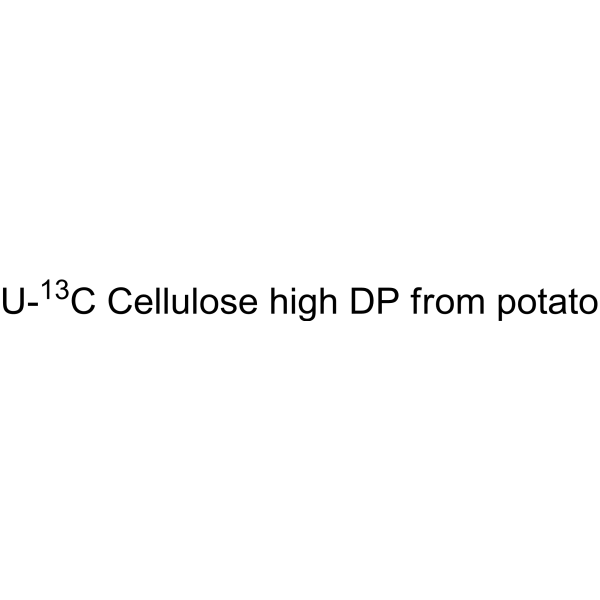
-
- HY-B2221S3
-
|
|
Isotope-Labeled Compounds
Endogenous Metabolite
|
Others
|
|
U- 13C Cellulose high DP from maize is the 13C labeled Cellulose (HY-B2221). Cellulose (Pectin glycosidase) is a natural high molecular weight polysaccharide found in many plants and organisms. It is widely used in manufacturing industries, such as in paper making, textiles, food and medicine, etc. As a renewable resource, Cellulose is biodegradable and sustainable, and can also be used to manufacture chemicals such as Cellulose Esters, Cellulose Acetate and Cellulose Nitrate. In addition, Cellulose is often used as a food additive to increase the stability and quality of food .
|
-
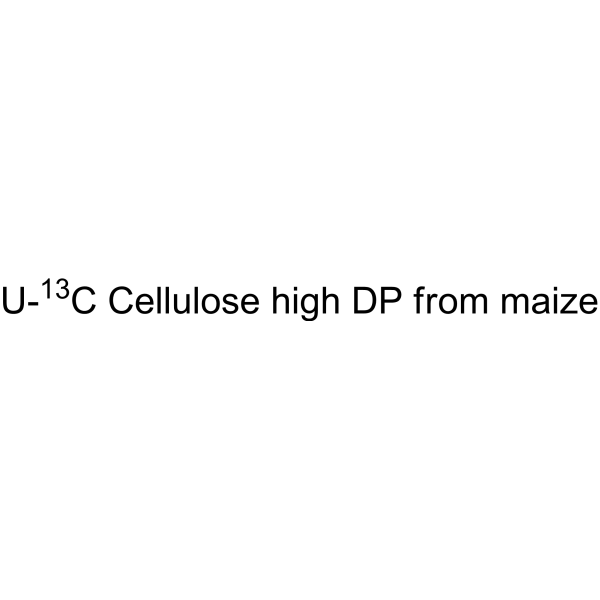
-
- HY-W250308
-
|
Epsilon-polylysine; ε-Polylysine; ε-PL
|
Bacterial
|
Others
|
|
Epsilon-polylysine is an antimicrobial peptide that can be produced by bacteria such as Streptomyces. Epsilon-polylysine inhibits the growth of microorganisms such as bacteria, yeasts and molds and is therefore often used as a green food additive and preservative in various food and beverage products. Epsilon-polylysine has a variety of properties, including thermal stability, resistance to acidic conditions, and broad-spectrum antimicrobial activity. Epsilon-polylysine can be loaded on other materials to form nanoparticles or form nanofiber membranes for targeted delivery to exert sustained antibacterial efficacy. Epsilon-polylysine is also used as a liposome stabilizer .
|
-
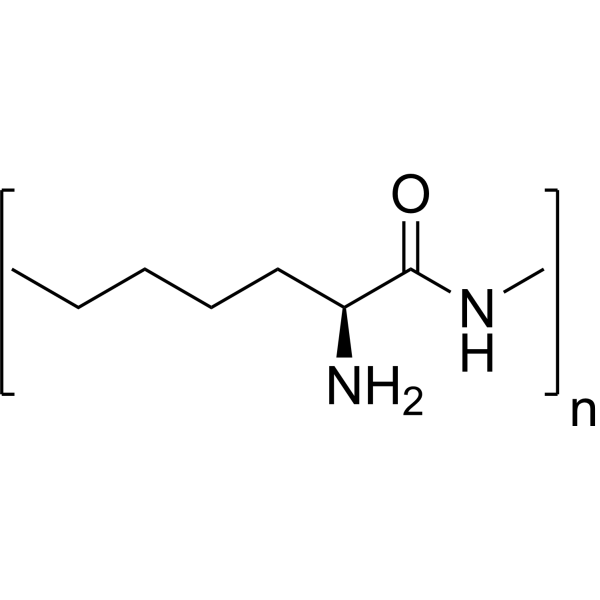
-
- HY-134524
-
|
Dimethyl isosorbide; O,O-Dimethylisosorbide
|
Biochemical Assay Reagents
|
Others
|
|
Isosorbide dimethyl ether is a biobased high boiling green solvent. Isosorbide dimethyl ether can be used for sustainable ultrafiltration and microfiltration membrane preparation. Isosorbide dimethyl ether can be used as an excipient, such as solvent, penetration aid. Pharmaceutical excipients, or pharmaceutical auxiliaries, refer to other chemical substances used in the pharmaceutical process other than pharmaceutical ingredients. Pharmaceutical excipients generally refer to inactive ingredients in pharmaceutical preparations, which can improve the stability, solubility and processability of pharmaceutical preparations. Pharmaceutical excipients also affect the absorption, distribution, metabolism, and elimination (ADME) processes of co-administered drugs .
|
-

-
- HY-P1032S
-
|
|
Isotope-Labeled Compounds
Endogenous Metabolite
|
Others
|
|
Angiotensin I- 13C19, 15N3 (human, mouse, rat) is the 13C and 15N labeled Angiotensin I (human, mouse, rat) (HY-P1032). Cellulose (Pectin glycosidase) is a natural high molecular weight polysaccharide found in many plants and organisms. It is widely used in manufacturing industries, such as in paper making, textiles, food and medicine, etc. As a renewable resource, Cellulose is biodegradable and sustainable, and can also be used to manufacture chemicals such as Cellulose Esters, Cellulose Acetate and Cellulose Nitrate. In addition, Cellulose is often used as a food additive to increase the stability and quality of food .
|
-
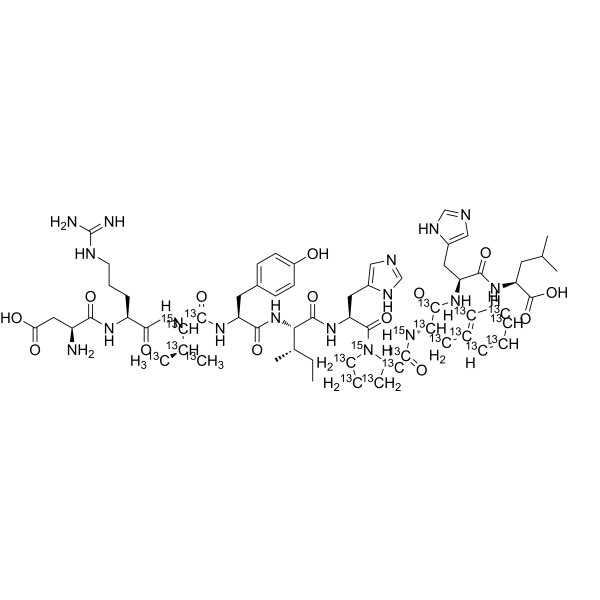
- HY-P1845
-
|
|
ERK
EGFR
Reactive Oxygen Species
Calcium Channel
|
Neurological Disease
|
|
PACAP-38 (31-38), human, mouse, rat is a PAC1 receptor activator and increases the α-secretase activity. PACAP-38 (31-38), human, mouse, rat elevates cytosolic Ca 2+, increases proliferation and increases phosphorylation of extracellular regulates kinase (ERK) and the epidermal growth factor receptor (EGFR). PACAP-38 (31-38), human, mouse, rat demonstrates potent, efficacious, and sustained stimulatory effects on sympathetic neuronal NPY and catecholamine production. PACAP-38 (31-38), human, mouse, rat can be used for neurotrophic and neuroprotective research .
|
-
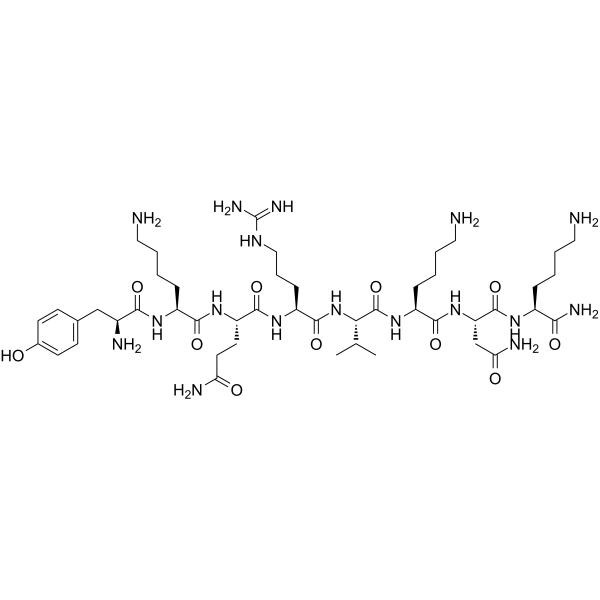
- HY-P1845A
-
|
|
ERK
EGFR
Reactive Oxygen Species
Calcium Channel
|
Neurological Disease
|
|
PACAP-38 (31-38), human, mouse, rat TFA is a PAC1 receptor activator and increases the α-secretase activity. PACAP-38 (31-38), human, mouse, rat TFA elevates cytosolic Ca 2+, increases proliferation and increases phosphorylation of extracellular regulates kinase (ERK) and the epidermal growth factor receptor (EGFR). PACAP-38 (31-38), human, mouse, rat TFA demonstrates potent, efficacious, and sustained stimulatory effects on sympathetic neuronal NPY and catecholamine production. PACAP-38 (31-38), human, mouse, rat TFA can be used for neurotrophic and neuroprotective research .
|
-

-
-
HY-L146
-
|
|
2829 Compounds compounds
|
|
Metabolism is the set of life-sustaining chemical reactions in organisms that maintain cell homeostasis. Metabolic pathways are enzyme-mediated biochemical reactions that lead to biosynthesis (anabolism) or breakdown (catabolism) of molecules including glucose metabolism, lipid metabolism and amino acid or protein metabolism within a cell or tissue. As catalysts, enzymes are crucial to metabolism as they allow a reaction to proceed more rapidly and tregulate the rate of a metabolic reaction. Due to the importance of metabolic balance in the organism, the abnormal function of metabolic enzymes often leads to the occurrence of a variety of metabolic diseases, such as diabetes, obesity, cardiovascular disease, etc.
MCE designs a unique collection of 2829 metabolic enzymes related small molecules, which is an important tool for studying the metabolic activities of organisms and developing drugs for metabolic diseases.
|
-
-
HY-L012
-
|
|
4431 compounds
|
|
Metabolism is the set of life-sustaining chemical reactions in organisms. Metabolic pathways are enzyme-mediated biochemical reactions that lead to biosynthesis (anabolism) or breakdown (catabolism) of natural product small molecules within a cell or tissue. Acting as catalysts, enzymes are crucial to metabolism - they allow a reaction to proceed more rapidly - and they also allow the regulation of the rate of a metabolic reaction. Proteases are used throughout an organism for various metabolic processes. Proteases control a great variety of physiological processes that are critical for life, including the immune response, cell cycle, cell death, wound healing, food digestion, and protein and organelle recycling. Imbalances in metabolic activities have been found to be critical in a number of pathologies, such as cardiovascular diseases, inflammation, cancer, and neurodegenerative diseases.
MCE designs a unique collection of 4431 Metabolism/Protease-related small molecules that act as a useful tool for drug discovery of metabolism-related diseases.
|
| Cat. No. |
Product Name |
Type |
-
- HY-W250308
-
|
Epsilon-polylysine; ε-Polylysine; ε-PL
|
Biochemical Assay Reagents
|
|
Epsilon-polylysine is an antimicrobial peptide that can be produced by bacteria such as Streptomyces. Epsilon-polylysine inhibits the growth of microorganisms such as bacteria, yeasts and molds and is therefore often used as a green food additive and preservative in various food and beverage products. Epsilon-polylysine has a variety of properties, including thermal stability, resistance to acidic conditions, and broad-spectrum antimicrobial activity. Epsilon-polylysine can be loaded on other materials to form nanoparticles or form nanofiber membranes for targeted delivery to exert sustained antibacterial efficacy. Epsilon-polylysine is also used as a liposome stabilizer .
|
| Cat. No. |
Product Name |
Target |
Research Area |
-
- HY-P5819A
-
|
|
PROTACs
β-catenin
|
Cancer
|
|
xStAx-VHLL TFA, a PROTAC, sustains β-catenin degradation and manifested strong inhibition of Wnt signaling. xStAx-VHLL TFA promotes β-catenin ubiquitination .
|
-
- HY-P5921
-
|
TsTx-Kα
|
Peptides
|
Neurological Disease
|
|
Tityustoxin-Kα (TsTx-Kα) is an inhibitor of potassium voltage-gated channels. Tityustoxin-Kα shows a dose-dependent block of the sustained outward current in cultured hippocampal neurons .
|
-
- HY-P1817
-
|
|
PACAP Receptor
|
Neurological Disease
|
|
PACAP-38 (16-38), human, mouse, rat demonstrates potent, efficacious, and sustained stimulatory effects on sympathetic neuronal NPY and catecholamine production . PACAP is a potent activator of cAMP formation .
|
-
- HY-P4678
-
|
|
Vasopressin Receptor
|
Neurological Disease
|
|
(Phe2,Orn8)-Oxytocin is a selective V1 vasopressin agonist. (Phe2,Orn8)-Oxytocin induces a sustained contractility of rabbit epididymis with EC50 value of 280 nM .
|
-
- HY-P4678A
-
|
|
Vasopressin Receptor
|
Neurological Disease
|
|
(Phe2,Orn8)-Oxytocin acetate is a selective V1 vasopressin agonist. (Phe2,Orn8)-Oxytocin acetate induces a sustained contractility of rabbit epididymis with EC50 value of 280 nM .
|
-
- HY-P1249
-
|
|
Neuropeptide Y Receptor
|
Neurological Disease
|
|
Neuropeptide SF (mouse,rat) is a potent neuropeptide FF receptor agonist with Ki values are 48.4 nM and 12.1 nM for NPFF1 and NPFF2, respectively. Neuropeptide SF increases the amplitude of the sustained current of heterologously expressed acid sensing ion channel 3 (ASIC3) .
|
-
- HY-P5819
-
|
|
Wnt
APC
PROTACs
β-catenin
|
Cancer
|
|
xStAx-VHLL is a PROTAC β-catenin degrader that manifests strong inhibition of Wnt signaling and sustains degradation of β-catenin in cancer cells and the intestinal organoids derived from wild-type and APC –/– mice. xStAx-VHLL can be used as a promising anticancer agent .
|
-
- HY-P1249A
-
|
|
Neuropeptide Y Receptor
|
Neurological Disease
|
|
Neuropeptide SF (mouse,rat) TFA is a potent neuropeptide FF receptor agonist with Ki values are 48.4 nM and 12.1 nM for NPFF1 and NPFF2, respectively. Neuropeptide SF TFA increases the amplitude of the sustained current of heterologously expressed acid sensing ion channel 3 (ASIC3) .
|
-
- HY-P5163
-
|
|
Peptides
|
Inflammation/Immunology
|
|
NMB-1 is a conopeptide analogue. NMB-1 selectively inhibits sustained mechanically activated currents in sensory neurons (IC50: 1 μM). NMB-1 inhibits mechanical pain. NMB-1 can be used for research of hearing and pressure-evoked pain .
|
-
- HY-P3444
-
|
PECAM-1
|
SHP2
Bacterial
|
Metabolic Disease
Inflammation/Immunology
|
|
CD31 (PECAM-1) is platelet endothelial cell adhesion molecule-1, serves as the endothelial cell-specific receptor of clostridium perfringens b-Toxin (CPB). CD31 is also an ER-MP12 antigen, acts as a linker between mechanical stress, metabolism and inflammation. CD31 peptide is able to sustain phosphorylation of the CD31 ITIM686 and of SHP2 and to inhibit TCR-induced T-cell activation - .
|
-
- HY-P3444A
-
|
PECAM-1 TFA
|
SHP2
Bacterial
|
Metabolic Disease
Inflammation/Immunology
|
|
CD31 (PECAM-1) TFA is platelet endothelial cell adhesion molecule-1, serves as the endothelial cell-specific receptor of clostridium perfringens b-Toxin (CPB). CD31 TFA is also an ER-MP12 antigen, acts as a linker between mechanical stress, metabolism and inflammation. CD31 TFA peptide is able to sustain phosphorylation of the CD31 ITIM686 and of SHP2 and to inhibit TCR-induced T-cell activation - .
|
-
- HY-P1032S
-
|
|
Isotope-Labeled Compounds
Endogenous Metabolite
|
Others
|
|
Angiotensin I- 13C19, 15N3 (human, mouse, rat) is the 13C and 15N labeled Angiotensin I (human, mouse, rat) (HY-P1032). Cellulose (Pectin glycosidase) is a natural high molecular weight polysaccharide found in many plants and organisms. It is widely used in manufacturing industries, such as in paper making, textiles, food and medicine, etc. As a renewable resource, Cellulose is biodegradable and sustainable, and can also be used to manufacture chemicals such as Cellulose Esters, Cellulose Acetate and Cellulose Nitrate. In addition, Cellulose is often used as a food additive to increase the stability and quality of food .
|
-
- HY-P1845
-
|
|
ERK
EGFR
Reactive Oxygen Species
Calcium Channel
|
Neurological Disease
|
|
PACAP-38 (31-38), human, mouse, rat is a PAC1 receptor activator and increases the α-secretase activity. PACAP-38 (31-38), human, mouse, rat elevates cytosolic Ca 2+, increases proliferation and increases phosphorylation of extracellular regulates kinase (ERK) and the epidermal growth factor receptor (EGFR). PACAP-38 (31-38), human, mouse, rat demonstrates potent, efficacious, and sustained stimulatory effects on sympathetic neuronal NPY and catecholamine production. PACAP-38 (31-38), human, mouse, rat can be used for neurotrophic and neuroprotective research .
|
-
- HY-P1845A
-
|
|
ERK
EGFR
Reactive Oxygen Species
Calcium Channel
|
Neurological Disease
|
|
PACAP-38 (31-38), human, mouse, rat TFA is a PAC1 receptor activator and increases the α-secretase activity. PACAP-38 (31-38), human, mouse, rat TFA elevates cytosolic Ca 2+, increases proliferation and increases phosphorylation of extracellular regulates kinase (ERK) and the epidermal growth factor receptor (EGFR). PACAP-38 (31-38), human, mouse, rat TFA demonstrates potent, efficacious, and sustained stimulatory effects on sympathetic neuronal NPY and catecholamine production. PACAP-38 (31-38), human, mouse, rat TFA can be used for neurotrophic and neuroprotective research .
|
| Cat. No. |
Product Name |
Target |
Research Area |
-
- HY-P99022
-
|
|
Amyloid-β
|
Neurological Disease
|
|
Gantenerumab is a fully human anti-amyloid-β (Aβ) IgG1 monoclonal antibody demonstrates sustained cerebral amyloid-β binding. Gantenerumab can be used for Alzheimer's disease research .
|
-
- HY-P99790
-
|
CEN 000029; cM-T412
|
Inhibitory Antibodies
|
Inflammation/Immunology
|
|
Priliximab (CEN 000029) is an anti-CD4 humanized monoclonal antibody. Priliximab binds to CD4 on the surface of T cells, resulting in a significant and sustained reduction in circulating CD4 + T cells. Priliximab can be used in research of rheumatoid arthritis (RA) .
|
-
- HY-P99846
-
|
QAX576
|
Interleukin Related
|
Inflammation/Immunology
|
|
Dectrekumab (QAX576) is a human monoclonal antibody that targets IL-13. Dectrekumab significantly improves intraepithelial esophageal eosinophil counts and dysregulated esophageal disease-related transcripts with Eosinophilic esophagitis (EoE) in a sustained manner and can be used for inflammation and immunology related research .
|
| Cat. No. |
Product Name |
Category |
Target |
Chemical Structure |
| Cat. No. |
Product Name |
Chemical Structure |
-
- HY-B2221S5
-
|
|
|
U- 13C Cellulose from broccoli is the 13C labeled Cellulose (HY-B2221). Cellulose is a natural high molecular weight polysaccharide found in many plants and organisms. It is widely used in manufacturing industries, such as in paper making, textiles, food and medicine, etc. As a renewable resource, Cellulose is biodegradable and sustainable, and can also be used to manufacture chemicals such as Cellulose Esters, Cellulose Acetate and Cellulose Nitrate. In addition, Cellulose is often used as a food additive to increase the stability and quality of food .
|
-

-
- HY-B2221S1
-
|
|
|
U- 13C Cellulose from chicory is the 13C labeled Cellulose (HY-B2221). Cellulose (Pectin glycosidase) is a natural high molecular weight polysaccharide found in many plants and organisms. It is widely used in manufacturing industries, such as in paper making, textiles, food and medicine, etc. As a renewable resource, Cellulose is biodegradable and sustainable, and can also be used to manufacture chemicals such as Cellulose Esters, Cellulose Acetate and Cellulose Nitrate. In addition, Cellulose is often used as a food additive to increase the stability and quality of food .
|
-

-
- HY-B2221S
-
|
|
|
U- 13C Cellulose high DP from potato is the 13C labeled Cellulose (HY-B2221). Cellulose (Pectin glycosidase) is a natural high molecular weight polysaccharide found in many plants and organisms. It is widely used in manufacturing industries, such as in paper making, textiles, food and medicine, etc. As a renewable resource, Cellulose is biodegradable and sustainable, and can also be used to manufacture chemicals such as Cellulose Esters, Cellulose Acetate and Cellulose Nitrate. In addition, Cellulose is often used as a food additive to increase the stability and quality of food .
|
-

-
- HY-B2221S3
-
|
|
|
U- 13C Cellulose high DP from maize is the 13C labeled Cellulose (HY-B2221). Cellulose (Pectin glycosidase) is a natural high molecular weight polysaccharide found in many plants and organisms. It is widely used in manufacturing industries, such as in paper making, textiles, food and medicine, etc. As a renewable resource, Cellulose is biodegradable and sustainable, and can also be used to manufacture chemicals such as Cellulose Esters, Cellulose Acetate and Cellulose Nitrate. In addition, Cellulose is often used as a food additive to increase the stability and quality of food .
|
-

-
- HY-P1032S
-
|
|
|
Angiotensin I- 13C19, 15N3 (human, mouse, rat) is the 13C and 15N labeled Angiotensin I (human, mouse, rat) (HY-P1032). Cellulose (Pectin glycosidase) is a natural high molecular weight polysaccharide found in many plants and organisms. It is widely used in manufacturing industries, such as in paper making, textiles, food and medicine, etc. As a renewable resource, Cellulose is biodegradable and sustainable, and can also be used to manufacture chemicals such as Cellulose Esters, Cellulose Acetate and Cellulose Nitrate. In addition, Cellulose is often used as a food additive to increase the stability and quality of food .
|
-

Your information is safe with us. * Required Fields.
Inquiry Information
- Product Name:
- Cat. No.:
- Quantity:
- MCE Japan Authorized Agent:




























































